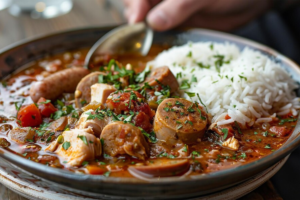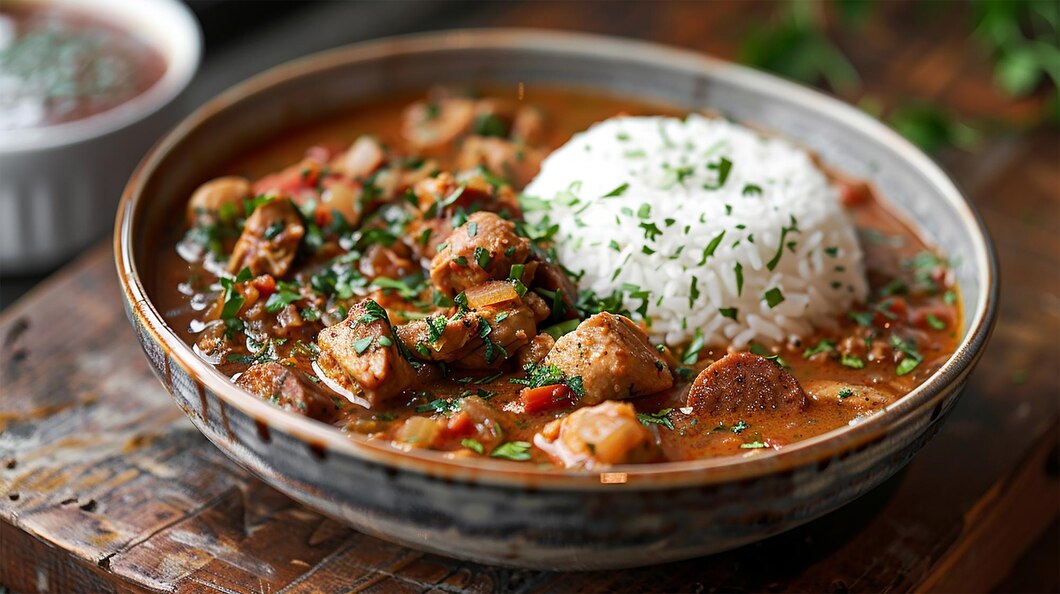If you’re looking to savor the essence of Louisiana cuisine, few dishes can rival the rich, smoky flavors of chicken and sausage gumbo. With deep cultural roots and a comforting heartiness, gumbo has become synonymous with Cajun and Creole cooking, loved by people across the globe.
In this guide, we’ll walk you through everything you need to know about making a perfect chicken and sausage gumbo from scratch. This includes the key ingredients, cooking techniques, and how you can tweak it to fit your preferences. Whether you’re new to making gumbo or a seasoned cook, this recipe offers the perfect blend of tradition, flavor, and adaptability. Let’s dive into the rich world of gumbo!
A Brief History of Gumbo: Louisiana’s Culinary Treasure.
The history of gumbo is as rich as its flavor. It originated in Louisiana in the 18th century, combining elements from French, Spanish, African, and Native American cuisines. The dish embodies the diverse culinary traditions of the region, with each culture leaving its mark on the recipe.
Typically, gumbo consists of a flavorful roux, vegetables, meat (or seafood), and spices simmered into a thick stew. While there are many variations, chicken and sausage gumbo is one of the most iconic, combining smoky sausage and tender chicken with bold spices for a deeply satisfying dish.
Why Chicken and Sausage Gumbo Is Special.
What sets chicken and sausage gumbo apart from other stews? It’s all about the complex, layered flavors. The smoky richness of andouille sausage, the savory punch of tender shredded chicken, and the magic of a perfectly browned roux come together to create a dish that’s unlike any other.
In fact, the secret to a good gumbo lies in balancing the flavors and taking your time, especially when preparing the roux. A slow-cooked roux gives the dish its nutty depth and thick consistency. Moreover, the holy trinity of onions, celery, and bell peppers—a hallmark of Cajun cuisine—provides a fresh and flavorful base for the gumbo.
Essential Ingredients for Chicken and Sausage Gumbo.
1. Andouille Sausage
Andouille sausage is a spicy, smoked sausage that’s a staple in many gumbo recipes. However, if andouille is unavailable, smoked sausage or kielbasa can be used as substitutes, but keep in mind that the sausage imparts a unique smokiness that’s critical to the overall flavor.
2. Chicken
While fresh chicken works wonderfully in gumbo, many recipes use rotisserie chicken for convenience. The chicken is usually shredded and added towards the end of cooking, allowing it to soak up the stew’s flavors without becoming overcooked.
3. The Roux
A proper roux is the foundation of every gumbo. It’s a mixture of flour and oil (or butter) cooked together until it turns a deep, rich brown. Consequently, the darker the roux, the more intense the flavor. You’ll want to take your time with this step, as a properly cooked roux adds the essential nutty flavor and thickness to the dish.
4. The Holy Trinity: Onions, Bell Peppers, and Celery
No gumbo is complete without the holy trinity of Cajun cuisine: onions, bell peppers, and celery. These vegetables form the aromatic base of the gumbo and enhance its depth of flavor.
5. Spices and Seasonings
Creole seasoning, garlic, bay leaves, and Cajun spices are the key to elevating the flavors in your gumbo. Adjust the seasonings to suit your preferred level of spice.
6. Chicken Broth
A good-quality chicken broth serves as the liquid base, blending all the ingredients together. Opt for a low-sodium broth so you can control the salt level as the gumbo simmers.
7. Okra or File Powder (Optional)
Traditionally, okra or file powder is used to thicken the gumbo. If you don’t have access to these, the roux will do most of the work. However, adding either will give the dish an authentic texture.
Step-by-Step Recipe: How to Make Chicken and Sausage Gumbo.
Step 1: Make the Roux
The most critical step in making gumbo is preparing the roux. A dark roux is what gives the gumbo its distinctive flavor and color.
- Heat 1 cup of vegetable oil in a large heavy-bottomed pot over medium heat.
- Slowly whisk in 1 cup of all-purpose flour.
- Continue whisking the mixture constantly for 10–15 minutes. The roux should gradually darken to a deep chocolate brown color. Be sure not to burn it; if you see black specks, you’ll need to start over.
Pro Tip: Stir constantly and keep the heat low to avoid burning the roux.
Step 2: Add Sausage and Vegetables
Once your roux reaches the perfect color, it’s time to add the andouille sausage and vegetables.
- Slice 1 pound of andouille sausage into rounds and brown it in the roux for 5 minutes.
- Add 1 large chopped onion, 1 large chopped bell pepper, and 2 chopped celery stalks (the holy trinity) to the pot. Cook for another 5 minutes until softened.
- Add 4 cloves of minced garlic and sauté for an additional minute.
Step 3: Simmer the Gumbo
With your vegetables and sausage cooked, it’s time to add the liquid and seasonings.
- Slowly pour in 6 cups of chicken broth while stirring constantly to combine with the roux.
- Add 1 bay leaf and 1-2 tablespoons of Creole seasoning.
- Bring the mixture to a boil, then reduce the heat to low and let it simmer uncovered for 45 minutes, stirring occasionally.
Skim any foam from the top as the gumbo simmers to keep the broth clean and smooth.
Step 4: Add Chicken and Final Simmer
After 45 minutes, it’s time to add the chicken to your gumbo.
- Shred the meat from a rotisserie chicken (about 4 cups) and add it to the pot.
- Continue to simmer for another 30–45 minutes to allow the chicken to absorb the flavors.
Step 5: Adjust Seasonings and Serve
Taste your gumbo and adjust the seasonings as needed. You may want to add more Creole seasoning, salt, or pepper to suit your taste.
- Remove the bay leaf and serve the gumbo over a bed of white rice.
- Garnish with chopped green onions or parsley for a fresh finish.
Tips for Making the Perfect Gumbo

1. Don’t Rush the Roux
Patience is key when making a roux. It may take 15 minutes or longer to reach the desired color, but it’s worth the effort. A darker roux adds a deeper, richer flavor to the gumbo.
2. Brown the Sausage First
Browning the sausage before adding the vegetables helps release its oils and enhances the smoky flavor of the dish. It’s a simple step that makes a big difference.
3. Control the Heat
Once you add the chicken broth, be sure to lower the heat and let the gumbo simmer gently. A slow simmer allows the flavors to meld together without overcooking the meat or vegetables.
4. Make It Ahead
Gumbo often tastes better the next day as the flavors have more time to develop. Therefore, feel free to make your gumbo a day in advance and reheat it when you’re ready to serve.
Variations and Additions to Chicken and Sausage Gumbo
Gumbo is a versatile dish, and there are plenty of ways to customize it according to your taste. Here are a few ideas to get you started:
1. Add Seafood
If you’re a fan of seafood, adding shrimp, crab, or crawfish is a great way to elevate your gumbo. Seafood gumbo is another classic version of the dish that brings the flavors of the Louisiana coast to your table.
2. Make It Vegetarian
For a vegetarian option, swap the chicken and sausage for plant-based sausages and extra vegetables like okra and tomatoes. The same roux and seasoning method will still give you a deliciously rich and hearty dish.
3. Healthy Gumbo
Looking for a lighter version? Reduce the amount of oil used in the roux, opt for chicken sausage or turkey sausage, and use low-sodium chicken broth to cut down on the salt.
4. Spice It Up
If you like your gumbo extra spicy, add a pinch of cayenne pepper or hot sauce toward the end of cooking. You can also increase the amount of Creole seasoning for an extra kick.
Frequently Asked Questions (FAQs)
1. What’s the difference between Cajun and Creole gumbo?
Cajun gumbo typically features a darker roux and often excludes tomatoes, whereas Creole gumbo might include tomatoes and has a slightly lighter roux. Both versions are delicious, but the difference lies in the base ingredients and cooking techniques.
2. Can you make gumbo without a roux?
Technically, yes, but the roux is what gives gumbo its distinctive thick texture and nutty flavor. Skipping the roux would result in a thinner, less flavorful broth. If you’re gluten-free, consider using a roux made from alternative flours like gluten-free flour or cornstarch.
3. How long does gumbo need to cook?
Gumbo should simmer for at least 1.5 to 2 hours to allow the flavors to meld together. If you’re adding seafood, do so in the last 30 minutes to prevent overcooking.
4. Does gumbo taste better the next day?
Yes! Gumbo often tastes even better the next day as the flavors have more time to develop and meld together. It’s a great dish to make ahead of time for gatherings or meal prep.
5. Can you freeze gumbo?
Yes, gumbo freezes very well. Just be sure to let it cool completely before transferring it to freezer-safe containers. Gumbo can be stored in the freezer for up to 3 months.
Nutritional Information
Chicken and sausage gumbo is a protein-rich dish that provides healthy fats, essential vitamins, and minerals. Here’s a breakdown of the nutritional information per serving:
- Calories: 450
- Protein: 20g
- Fat: 35g
- Carbohydrates: 15g
- Sodium: 1200mg
Final Thoughts
Whether you’re cooking for a family gathering, a holiday celebration, or simply craving some comfort food, chicken and sausage gumbo is the perfect choice. Its rich flavors, comforting texture, and cultural significance make it a dish worth mastering. Follow this guide, take your time with the roux, and don’t be afraid to experiment with different ingredients.
Ready to elevate your gumbo game? Try this Seafood Boil Recipe for another Louisiana-inspired dish that pairs perfectly with your gumbo.
Enjoy cooking, and share the deliciousness with family and friends!

